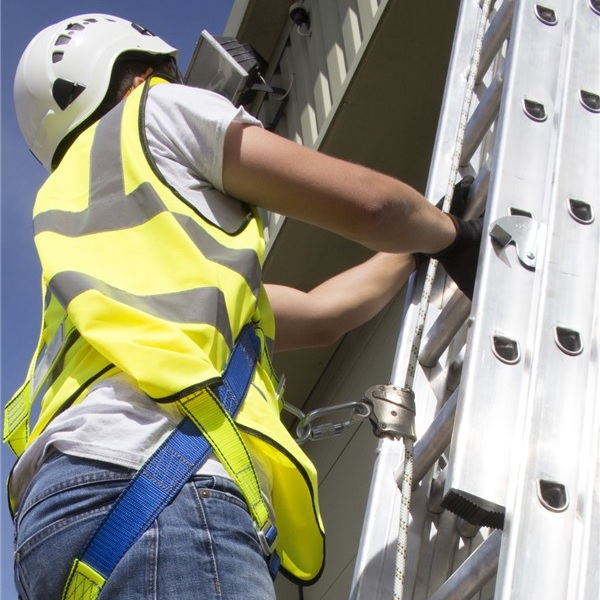
Ladder safety should always be your top priority if you or your employees use ladders to work at height. As you'd imagine, we take safety very seriously here at SafetyLiftinGear - here is our guide on how to use a ladder safely.
NOTE: This article is for informational purposes only and is no substitute for formal ladder safety training.
How to Use a Ladder Safely - HSE Ladder Safety Guidelines
Following the Health and Safety Executive's ladder safety guidelines is the best way to stay safe on a ladder.
HSE ladder safety guidelines state that you should:
Make sure you're using the right type of ladder.
Obviously you need a ladder that's tall enough for the task at hand, but height is not the only factor you need to think about. There are many different types of ladder - including step ladders, leaning ladders, and 'combination' ladders that can be transformed into multiple configurations. In all work situations, you should think about whether you're using the right sort of ladder for the job.
For example, a leaning ladder should only be used if you've got a sturdy surface to rest it on. If you would have to lean your extension ladder against a window pane or plastic gutter, consider using a freestanding step ladder instead.
What the ladder is made of can also be important. Fibreglass ladders, for instance, are preferable to aluminium ladders if you're working with electricity.
In certain cases, a ladder may not be appropriate at all. According to the HSE guidelines, you should NOT use a ladder if...
- The job would require you to stay on the ladder for more than 30 minutes at a time
- The ground is uneven or unstable
- There are hazards nearby (e.g. vehicles in motion, outward-opening doors) that could strike the ladder and knock it over
Inspect the ladder for defects before use.
Before you make a start, check every part of the ladder (including the feet, the side rails, the locking mechanism and the steps / rungs) for signs of damage.
If you spot any defects, do not use the ladder as it may be unsafe.
Set up the ladder correctly.
If you're using a step ladder, make sure that...
- All feet are firmly in contact with the ground - the ladder shouldn't wobble at all.
- Any locking mechanisms are properly engaged.
- The step ladder is positioned appropriately. If possible, place the ladder so that you're facing the work site directly rather than standing alongside it.
If it's a leaning ladder, then...
- Use the 1-in-4 rule to make sure the ladder is positioned at a safe angle. This rule says that the ladder should be one space out for every four spaces up. Example: if the top of your ladder is resting against a wall at a point that's FOUR metres off the ground, the bottom of the ladder should be ONE metre away from the wall.
- Stand the ladder on a solid, level surface that's not slippery or prone to moving around.
- Lean the ladder against a sturdy resting point that won't move or give way.
- Stay at least 6 metres away from any overhead power lines.
- Secure the ladder before you start climbing. Tie your ladder to a sturdy anchor point to keep it from slipping, or use a suitable ladder stabiliser to keep it steady. DON'T ask someone else to 'foot' the ladder except as an absolute last resort.
Be careful when you're on the ladder.
Follow these rules when using any type of ladder:
- Don't exceed the ladder's maximum weight capacity. Think twice before carrying heavy objects as these, combined with your body weight, may overload the ladder.
- Try to maintain three points of contact with the ladder at all times. Both feet and one hand is ideal, but if you need both hands free, you can use your knees or chest to create a third point of contact.
- Follow the belt buckle rule: keep your belt buckle between the ladder rails to avoid overreaching. Leaning too far to one side may cause the ladder to unbalance and fall over.
- Don't rush up and down the ladder. Face forward, grip the ladder firmly, and take the rungs / steps one at a time.
- Never try to move or adjust the ladder while it's in use. Get off the ladder first, then reposition it as needed.
- Don't stand on the top three rungs of a ladder (or the top three steps of a swingback step ladder) as this would place a large section of your body beyond the top of the ladder and leave you without a suitable handhold.
Additionally, be sure to follow any guidance provided by the ladder's manufacturer.
Ladder Safety Equipment
The above ladder safety guidelines will help to minimise risk when you're using a ladder. However, accidents can still happen, so it's worth investing in the right safety equipment if you frequently work at height.
Our ladder safety kits are designed to help you stay safe on ladders, and they make it easier to maintain three points of contact without hampering your work. Use the links below to browse our range of ladders and ladder safety products.
Buy Ladders Buy Ladder Safety Equipment

